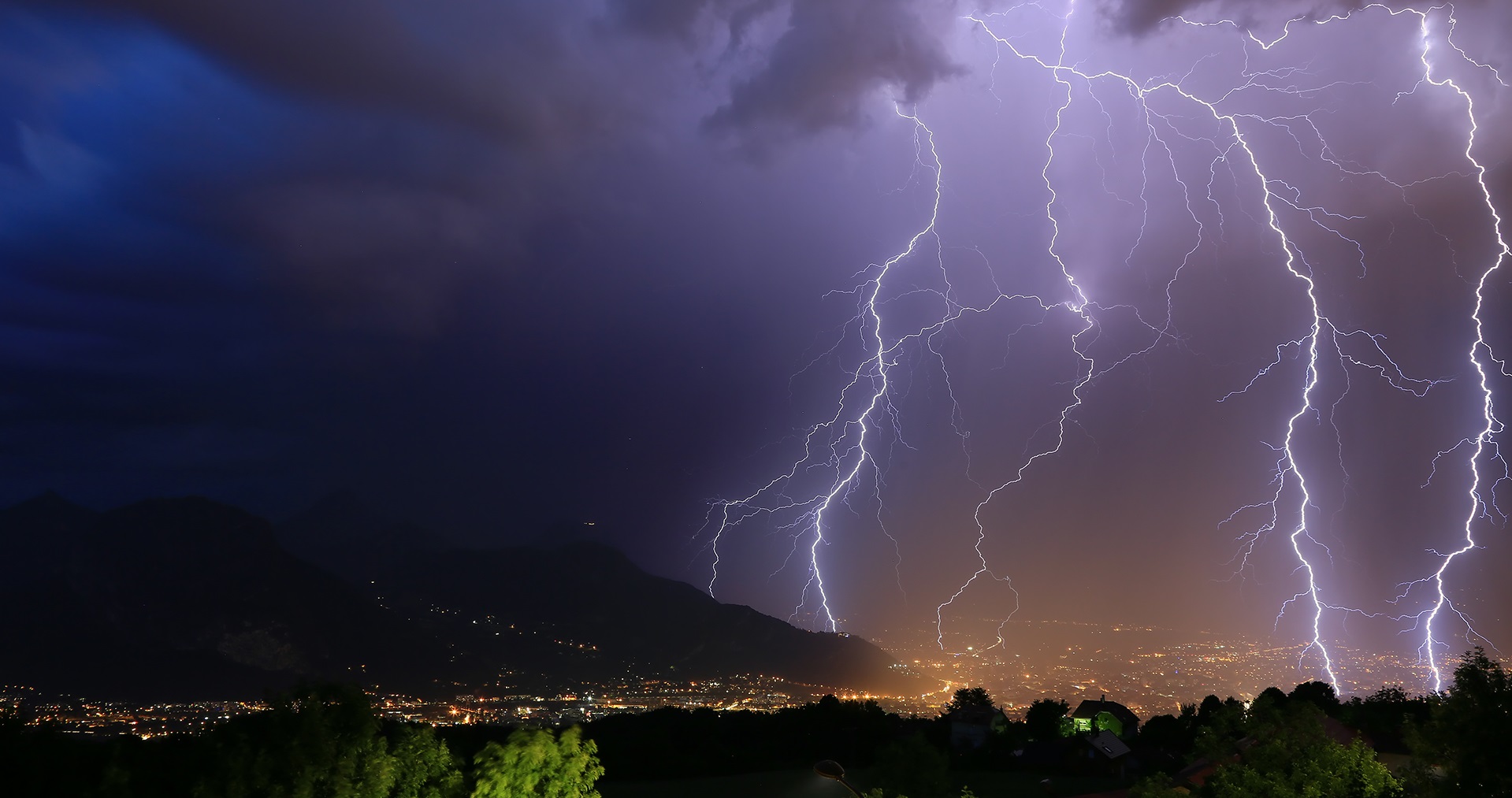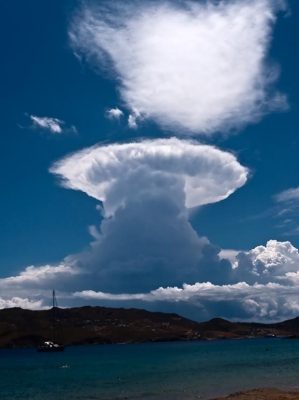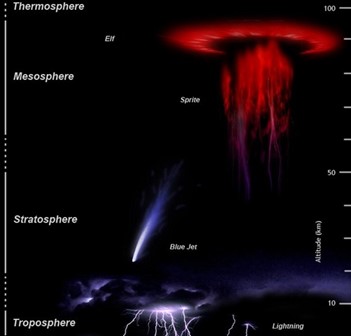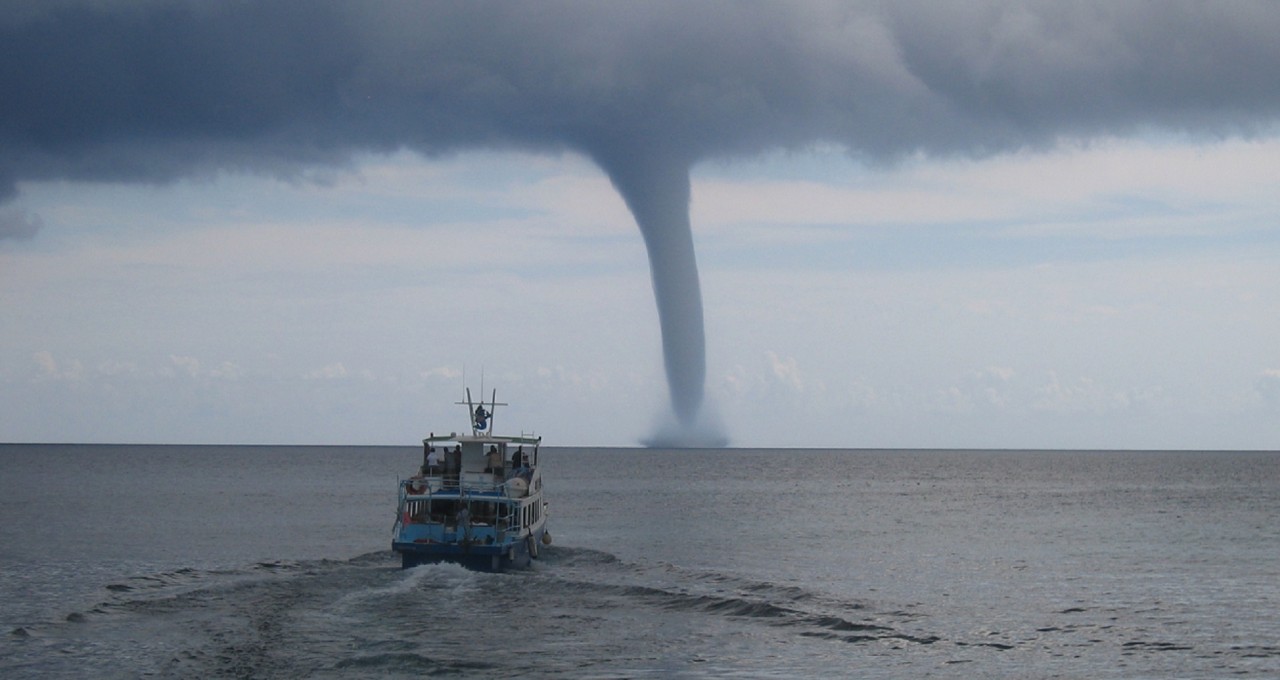雷暴:空中之电

雷暴诞生于积雨云之中,其形成常伴有暖湿空气上升、凝结、蒸发以及冷空气下沉等一系列过程,以及随之产生的强降水、阵风及电闪雷鸣,来势汹汹,震撼人心。本文将深入探究雷暴现象背后的支配力量,以及其带来的一系列后果。
1. 什么是雷暴?

一个对流单体(convective cell)便可构成最简单的雷暴结构,雷暴云体中心空气团上升,外沿空气团下沉,由此形成的云体即为积雨云(cumulonimbus)。积雨云向上延伸至对流层顶,垂直尺度可达10-15 km(详见《地球的大气层和气体层》),状似蘑菇(图1)。蘑菇状云体底部为上升气流,顶部由于空气在对流层顶水平向外辐散而形成云砧。由对流单体构成的积雨云(图1)水平尺度较小,据相关文献记载,其云砧的长度通常可达到10 km。积雨云有时由多单体构成,水平尺度可超过100 km,内含多组上升与下沉气流,但其中每个单体仍然遵循各自的动力机制及演化过程。

图2所示系统为飑线(squall lines),由几个并列的对流单体[1]组成(图2)。除此之外,对流结构还可构成其它系统。如气旋(详见《热带气旋:发展和结构》)就是从温暖的海表中获取能量,形成气旋性环流结构。无论哪种对流结构,都会因为云团中的水汽凝结而变得清晰可见。
2. 雷暴如何运作?
大气低层空气混合运动较为剧烈,空气团在湍流的作用下上下运动。在积雨云内部的上升运动过程中,随着环境大气压的不断降低(详见地球的大气层和气体层),气团气压也逐渐降低。由于气团鲜少与环境进行热量交换,所以其在绝热(adiabatic)(详见“热力学和熵”)状态下降压并逐渐冷却,达到水汽凝结所需的温压条件。除此之外,相态变化还需要凝结核(气溶胶或已经形成的小水滴)的参与。干燥大气的主要成分为氮气和氧气分子,水分子最初分散于这些分子之间,而后在凝结核的作用下,逐渐在其周围聚集,凝结成云。该过程常发生于上升运动伊始几百米范围内。在温度低于0℃的高空,水汽可直接凝华为冰晶,但液滴仍可能保持液态,称之为过冷状态(supercooling),该状态下的温度可低至-40℃。
蒸发过程会吸热,导致环境冷却,凝结过程则与之相反,可以释放潜热。一般而言,当对流层平均垂直温度递减率约为每公里下降6.5℃(详见《地球的大气层和气体层》)时,在积雨云上升气流区,这一数值仅为每公里下降5℃,故上升气流比其周边环境更暖且更轻。根据阿基米德浮力定律,空气将持续上升至与周围环境空气密度一致的高度。正因如此,积雨云才可垂直上升至10至15公里的高空,直至对流层顶。平流层(stratosphere)具有更高的温度,因而空气质量更轻,所以当上升气流到达该处时,便会遭受负浮力作用,导致垂直发展受阻。与此同时,下部气流仍在持续上升,推动云顶水平扩散,形成如图1所示的云砧。厚实的云层反射并吸收了大量太阳光,从而减少了到达地球表面的太阳辐射量,因此积雨云下往往略显黑暗[2](详见《天空的颜色》)。
对流伊始,小水滴下降速度不敌上升气流速度,将保持上升或悬浮状态。部分水滴则会在运动过程中碰撞合并其他小水滴,变大变重,从而下落形成降雨。较大的冰晶也会由相似的过程形成雪花,其在下落至温度0℃以上的高度时,便会变回液态。冰雹则是冰粒和过冷水滴之间反复碰撞冻结形成的。部分冰雹在对流环流中可历经多次循环,到达温度低于-40℃的对流层上层时冻结为冰,下落至低层后再部分融化为水,导致其内部结构状似洋葱皮。
在高度4到8公里的对流层中部,空气较为干燥,当雷暴云团外围的降水经过该环境时,二者之间将会发生相互作用。干燥的空气导致部分下降水滴蒸发吸热,冷却环境空气,并拖曳周围空气,形成冷而重的下降气流,即不饱和下降(unsaturated descent)[3](图3)。下降气流到达地面后随即发生水平运动,该现象被称为密度流(density current)。这些密度流可产生迅猛的阵风,作为风暴来临的预警信号。雷暴传播的方式如图3所示,冷而重的气团在水平运动过程中可抬升原本处于低层的潜在不稳定气团,触发新的上升运动趋势。当雷暴云周围风场强度及垂直风切变较大时,雷暴环流将表现出明显的涡旋特征,可催生龙卷风(详见《龙卷风:强大的毁灭性漩涡》)。
3. 雷暴的条件
理解了雷暴的演变过程,便可推知有利于其发展的条件。在低层大气中,密度流中的阵风,海风以及山脉等皆可成为上升运动的触发机制,进而引发雷暴。
只有上升气流温度较环境更高,密度较环境更低,使得大气垂直结构足够不稳定,空气团才能够在被迫抬升后持续上升。在实际大气环境中,近地表的空气受到加热作用,尤其是阳光加热作用时,往往会导致大气结构不稳定,这也是大陆上阳光明媚的夏天风暴频发的原因。此外,上升气流凝结成云的前提是其中包含充足的水分,能够在凝结为液滴和冰晶的过程中释放潜热。
4. 闪电和雷
作为雷暴最广为人知的光现象,闪电由空气电离产生,其机制可总结如下[4]:冰粒子之间的碰撞伴随着电荷交换,其极性取决于环境温度。温度低于-15℃的环境中,较小的粒子(冰晶)携带正电荷,较大的粒子(霰或冰球)携带负电荷;温度高于-15℃的环境中,极性则会逆转,小晶体携带负电荷,大粒子携带正电荷。随着小晶体被上升气流输送至高空,大晶体下落至低层,电荷逐渐沉降。因此雷暴云整体电荷结构本质上为双极,其中负极位于温度介于-15到-40℃之间的风暴中心,正极位于温度低于-40℃的雷暴云顶部。部分雷暴云在温度高于-15℃的云底另有一个次生正极,此时雷暴云整体电荷结构为三极。
电荷逐步分离促使云中电场不断增强,最高电压可达到100 kV/m。电场具有排水性,因而会主动绕过空气中的水汽凝结体(液态水滴或冰粒),并其在附近加强,该过程可类比为车道上的障碍物导致堵车。当电压超过数百千伏每米时,空气便会产生局部导电性,从水汽凝结体的末端自发形成携带电荷的小火花,该现象被称为电晕效应(corona effect)[5]或峰值效应(peak effect)。许多例子都体现了电晕效应,如圣埃尔莫火(St. Elmo Fires),以及暴风雨天气中船只桅杆或机翼末端常见的小型放电现象。
小火花聚集形成数个长约几米的前导闪接,仅几微秒的时间内便可在云层中跳跃数百米。由于这种聚集相对零散随机,闪电通常呈现出多分叉的形状。当携带相反电荷的前导彼此相遇时,电荷被迅速中和,随即产生强电流通过电离通道,带来高达10000℃的高温。电离通道因此发出炫目光线,以及强烈的无线电波辐射。急剧升温导致空气以高于声速的速度急速膨胀,产生类似于飞机穿过声障时的冲击波。这种冲击波如声波一般向外传播,就形成了我们常见的雷声。因为声速为340 m/s,比光速慢100万倍,所以可以根据目视闪电和听闻雷声之间的时间差T,估测闪电发生的距离D,具体公式如下:D(km)≈T(s)/3。
能量较为充足的前导闪接可冲破云层,向外迅速传播,并通过峰值效应增强其前端电场。这种增强电场可作用于地表的各种尖端(如树木、建筑物顶端、山顶、甚至雨伞、高尔夫球杆或冰镐等),诱使其与前导闪接产生相同的电火花。随着地表产生的前导闪接向上发展,与来自云体的前导闪接相遇,雷暴与地面携带的电荷便彼此中和,激发云对地闪电,该类闪电常见于埃菲尔铁塔顶端或山顶十字架。但无论是云层内部,还是云层与地表之间,电荷皆难以一次性完全中和。因此,电离通道内还将继续发生类似的中和作用,次数可达十余次,总持续时间不到一秒,并产生肉眼可见的炫目返回弧。
闪电可视为一种导电通道,长度范围从100米到10公里不等,宽约几厘米。其两端电位差约几千万伏特,电流强度可超过一千安培,瞬时功率平均为100亿至1000亿瓦(10-100 GW,gigawatt,千兆瓦),远大于核反应堆瞬时功率。但是,闪电持续时间较短,一般仅有十分之几秒,且在空间和时间上都极具偶然性,所以通过雷暴产生的电力来解决能源问题的梦想终究难以实现。

Cumulonimbus 积雨云 condensation 凝结 propagation 传播 gusty winds阵风 re-evaporation 再蒸发
除闪电外,雷暴可产生另一短暂的光现象。这一鲜为人知,却撼人心魄的现象发生于云层之上,因此从地面上难以窥得其貌。瞬态光现象(transient light phenomena)[6][7](图4)往往发生于大气平流层和中间层(mesosphere)之间,距离海平面20到100公里。尽管诸多飞行员和宇航员都曾提及这一现象,但其研究历史至今不过20年。瞬态光现象源于强雷暴顶部的正放电,使得高空稀薄大气发生电离,并逐渐向上辐散。其色彩常为美丽的红橙色、蓝绿色以及靛蓝色,形状似光盘、光晕、水母或光束,因此,人们也赋予了它们诸多充满诗意的名称,如精灵、空气精灵、调皮鬼或蓝色急流等等。目前,法国空间研究中心(CNES)于2020年计划发起的“塔拉尼斯”航天任务[8],旨在从多个波段对这一罕为人知的现象进行细致观察。

Elf精灵 sprite矮妖 blue jet蓝色急流 lightning闪电 thermosphere热层 mesosphere中间层 stratosphere平流层 troposphere对流层 altitude海拔高度
5. 风暴与大气的相互作用
在赤道辐合带(ICTZ)(详见《大气环流》和《信风的关键作用》)等区域,对流积雨云水平尺度可达几百公里。云的周边是晴空,由于向外发出红外辐射(详见“热辐射”),失去能量而逐渐冷却,从而以小于1 cm/s的速度下降。相比之下,雷暴中部上升运动速度则高得多,可达到30 m/s[9](图5)。

Large scale convergence大尺度辐合 convective updraft对流上升运动 latent heat release潜热释放 subsiden of clear sky晴空区下沉运动 subtropical zone副热带地区 intertropical convergence zone热带辐合带 subsiden of Large scale大尺度下沉运动 updraft of Large scale大尺度上升运动
风暴和大尺度大气环流彼此之间存在放大效应,即正反馈[10]。一方面,大尺度上升气流有助于水汽积聚,从而促进雷暴形成。另一方面,雷暴形成时会释放潜热,有助于空气柱变轻,从而降低气压,促进大尺度气流辐合(图5)。因此,对流活动通常以大尺度、集群的形式出现。
雷暴对大气中的能量和水汽输送也起着重要作用。雷暴通过释放潜热加热高空空气,通过部分雨水蒸发冷却下层空气,因此有助于大气形成稳定的垂直温度结构。在对流云砧中,水汽和上层空气中的部分冰晶被挤出云体,使对流层上部和平流层下部更为湿润。平流层的湿度对温室效应和臭氧层的平衡十分重要。
参考资料及说明
封面图片:阿兰·赫劳特(Alain Herrault),Diverticimes(www.diverticimes.com),版权所有。
[1] Houze RA. (1977). Structure and dynamics of a tropical squall line system. My. Weather Rev. 105: 15401567.
[2] Craig F. Bohren (1997). Les nuages noirs, La Météorologie, 19: 49-51.
[3] Zipser, E. J. (1977). Mesoscale and convective-scale downdrafts as distinct components of squall-line structure. Monthly Weather Review, 105(12), 1568-1589.
[4] Roux, F. (1991). Thunderstorms. Editions Payot.
[5] https://wikipedia.org/wiki/Effet_corona
[6] Soula, S. and van der Velde, O. (2009) Transient light phenomena over storms: observation and production conditions. Meteorology, 64:20-31.
[7] Soula, S., Huet, P., van der Velde, O., Montanya, J., Barthe, B. and Bór, J. (2012). Of the jand giant ones above an isolated storm near Reunion Island. Meteorology, 77:30-40.
[8] https://taranis.cnes.fr/
[9] Emanuel, K. A., David Neelin, J., & Bretherton, C. S. (1994). On large-scale circulations in convecting atmospheres. Quarterly Journal of the Royal Meteorological Society, 120(519), 1111-1143
[10] Risi, C. and Duvel, J.-P. (2014). The omadden-Julian scillation, the main mode of intra-seasonal variability in the tropics. Meteorology, 86: 57-65.
环境百科全书由环境和能源百科全书协会出版 (www.a3e.fr),该协会与格勒诺布尔阿尔卑斯大学和格勒诺布尔INP有合同关系,并由法国科学院赞助。
引用这篇文章: RISI Camille, ROUX Frank (2024年2月24日), 雷暴:空中之电, 环境百科全书,咨询于 2025年4月5日 [在线ISSN 2555-0950]网址: https://www.encyclopedie-environnement.org/zh/air-zh/thunderstorms-electricity-in-the-air/.
环境百科全书中的文章是根据知识共享BY-NC-SA许可条款提供的,该许可授权复制的条件是:引用来源,不作商业使用,共享相同的初始条件,并且在每次重复使用或分发时复制知识共享BY-NC-SA许可声明。









